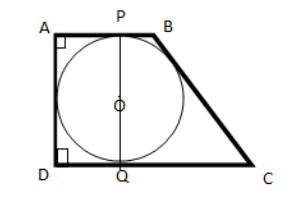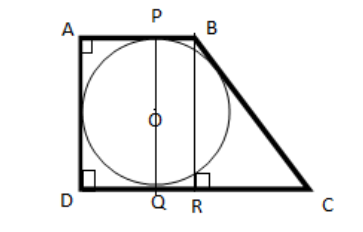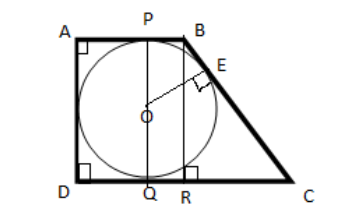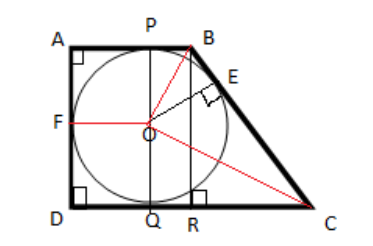
A right angled trapezium is circumscribed about a circle. The radius of the circle if the length of the bases (i.e. parallel sides) are equal to a and b is
A. $a+b$
B. $\dfrac{ab}{a+b}$
C. $\dfrac{a+b}{ab}$
D. $\left| a-b \right|$
Answer
508.8k+ views
Hint: A right angled trapezium has two adjacent right angles. Draw the diagram of trapezium circumscribed about a circle and use properties of the circle to get to your answer.
Complete step by step answer:
ABCD is a right angled trapezium circumscribed about a circle with centre O and let the radius of the circle be r.

P and Q are the points on the circle touching the sides of the right angled trapezium. Join them, PQ is the diameter of the circle
Let $AB=a$ (Given)
$CD=b$(Given)
$PQ=2r$(Diameter)
Draw a line BR parallel to PQ passing through vertex B and touching side CD at R.

$BR=PQ=2r$(By construction)
BC is the tangent to circle, OE is the radius therefore $\angle OEC={{90}^{\circ }}$ as tangent is perpendicular to the radius at the point of contact.

Join OB and OC

In $\Delta OEC$and$\Delta OQC$
$OC=OC$(Common side)
$\angle OEC=\angle OQC$(Each${{90}^{\circ }}$)
$OE=OQ$(Radius of the circle)
$\therefore \Delta OEC\cong \Delta OQC$ (RHS)
$CE=CQ$ (By CPCT)

OFDQ is a square with side r.
$OF=FD=DQ=OQ=r$
$CQ=CD-DQ$
$CQ=b-r$$=CE$
Similarly, $\Delta OPB\cong \Delta OEB$
$\therefore PB=BE$(By CPCT)
APOF is a square with side r
$AP=OP=OF=AF=r$
$\begin{align}
& PB=AB-AP \\
& PB=a-r=BE \\
\end{align}$
$BE+CE=BC$ and $BC=\sqrt{B{{R}^{2}}+C{{R}^{2}}}$ using Pythagoras Theorem on right triangle BRC right angled at R
$a-r+b-r=\sqrt{4{{r}^{^{2}}}+{{\left( b-a \right)}^{2}}}$
$\begin{align}
& {{(a+b-2r)}^{2}}=4{{r}^{2}}+{{\left( b-a \right)}^{2}} \\
& {{a}^{2}}+{{b}^{2}}+4{{r}^{2}}+2ab-4br-4ar=4{{r}^{2}}+{{b}^{2}}+{{a}^{2}}-2ab \\
\end{align}$
$\begin{align}
& 4ab=4ar+4br \\
& ab=r\left( a+b \right) \\
& \therefore r=\dfrac{ab}{a+b} \\
\end{align}$
Radius of the circle is $\dfrac{ab}{a+b}$.
So, the correct answer is “Option B”.
Note: You can also find the radius of the circle using a solution of triangles and basic trigonometric formula and that will be a shortcut too. For that you have to use $\sin 2\theta =\dfrac{2\tan \theta }{1+{{\tan }^{2}}\theta }$. Try finding a solution using this approach.
Complete step by step answer:
ABCD is a right angled trapezium circumscribed about a circle with centre O and let the radius of the circle be r.

P and Q are the points on the circle touching the sides of the right angled trapezium. Join them, PQ is the diameter of the circle
Let $AB=a$ (Given)
$CD=b$(Given)
$PQ=2r$(Diameter)
Draw a line BR parallel to PQ passing through vertex B and touching side CD at R.

$BR=PQ=2r$(By construction)
BC is the tangent to circle, OE is the radius therefore $\angle OEC={{90}^{\circ }}$ as tangent is perpendicular to the radius at the point of contact.

Join OB and OC

In $\Delta OEC$and$\Delta OQC$
$OC=OC$(Common side)
$\angle OEC=\angle OQC$(Each${{90}^{\circ }}$)
$OE=OQ$(Radius of the circle)
$\therefore \Delta OEC\cong \Delta OQC$ (RHS)
$CE=CQ$ (By CPCT)

OFDQ is a square with side r.
$OF=FD=DQ=OQ=r$
$CQ=CD-DQ$
$CQ=b-r$$=CE$
Similarly, $\Delta OPB\cong \Delta OEB$
$\therefore PB=BE$(By CPCT)
APOF is a square with side r
$AP=OP=OF=AF=r$
$\begin{align}
& PB=AB-AP \\
& PB=a-r=BE \\
\end{align}$
$BE+CE=BC$ and $BC=\sqrt{B{{R}^{2}}+C{{R}^{2}}}$ using Pythagoras Theorem on right triangle BRC right angled at R
$a-r+b-r=\sqrt{4{{r}^{^{2}}}+{{\left( b-a \right)}^{2}}}$
$\begin{align}
& {{(a+b-2r)}^{2}}=4{{r}^{2}}+{{\left( b-a \right)}^{2}} \\
& {{a}^{2}}+{{b}^{2}}+4{{r}^{2}}+2ab-4br-4ar=4{{r}^{2}}+{{b}^{2}}+{{a}^{2}}-2ab \\
\end{align}$
$\begin{align}
& 4ab=4ar+4br \\
& ab=r\left( a+b \right) \\
& \therefore r=\dfrac{ab}{a+b} \\
\end{align}$
Radius of the circle is $\dfrac{ab}{a+b}$.
So, the correct answer is “Option B”.
Note: You can also find the radius of the circle using a solution of triangles and basic trigonometric formula and that will be a shortcut too. For that you have to use $\sin 2\theta =\dfrac{2\tan \theta }{1+{{\tan }^{2}}\theta }$. Try finding a solution using this approach.
Recently Updated Pages
Master Class 10 General Knowledge: Engaging Questions & Answers for Success

Master Class 10 Science: Engaging Questions & Answers for Success

Master Class 10 Social Science: Engaging Questions & Answers for Success

Master Class 10 Maths: Engaging Questions & Answers for Success

Master Class 10 English: Engaging Questions & Answers for Success

Master Class 10 Computer Science: Engaging Questions & Answers for Success

Trending doubts
The shortest day of the year in India

Why is there a time difference of about 5 hours between class 10 social science CBSE

Write a letter to the principal requesting him to grant class 10 english CBSE

What is the median of the first 10 natural numbers class 10 maths CBSE

The Equation xxx + 2 is Satisfied when x is Equal to Class 10 Maths

State and prove converse of BPT Basic Proportionality class 10 maths CBSE




